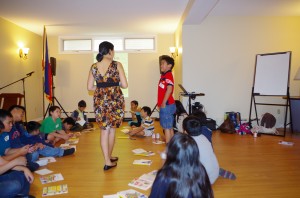Community News
Filipino-Canadian kids celebrate ‘Buwan ng Wika’
The Philippine Embassy opened the doors of Tahanang Rizal, the ambassador’s official residence, on Aug. 16, for its annual children’s day in Ottawa.
Now on its third year, the embassy’s ABaKaDa Atbp. affords children of Filipino heritage the opportunity to understand their cultural identity by appreciating Filipino language, history, dances, songs, stories, games and food.
Some 20 pupils greeted Chargé d’Affaires and Mrs. Eric Gerardo E. Tamayo with the mano, a time-honored tradition they learned at home and from previous runs of ABaKaDa. Reminiscent of flag ceremonies in Philippine schools, they stood at attention while singing the Lupang Hinirang in unison.
Vanessa Merjudio-David, ABS-CBN correspondent, led the review of the Filipino alphabet and numbers as well as introduced Filipino phrases and words, including parts of the body by way of the songs Paa, Tuhod, Balikat, Ulo and Sampung mga Daliri. The children learned to express their interests which invariably centered on games and food. “I’m happy to see that our kids are very eager to learn the Filipino language. And true to Filipino humor, their favorite new phrase was gutom na po ako!” Merjudio-David said.
Philippine Dance Troupe of Ottawa (PDTO) instructor Vanessa Solo Gomez challenged the kids to learn the art of Pandanggo sa Baso and Tinikling. She also encouraged them to join the growing PDTO and to learn more Philippine dances.”After learning a few steps, I believe that our young participants have a better appreciation of the skill and agility demanded by Filipino folk dances and the fun of it all,” Gomez observed.
Embassy’s Miguel Luis Moreno brought them back to days before the advent of console gaming and the internet, when children went out to play street games such as piko, luksong tinik and taguan. Moreno also explained the concept of taya where players determine the “it” through a process of elimination by a peculiar show of hands. Honoring Apolinario Mabini on his sesquicentennial, Moreno segued to the legacies of the hero as the Filipino icon of the differently-abled. He also presented other Philippine icons such as the bahay kubo, balut, sari-sari stores, arnis and the walis which the children thought was “a great way to use coconuts”.
Maura David, playing Lola Basyang, rounded out the program with the story of Itim na Pusa by Joyce Macorol. Testing their comprehension, David drew out the children’s thoughts on the story’s moral lessons.
As a special treat, Regina Sosing of Tinig Pinoy featured some of the participants in her radio program and allowed them to share the highlights of their day with listeners from around the world.
As in previous years, the program ended with the children receiving treats and presenting to their parents the day’s take-aways.
“ABaKaDaAtbp.






















